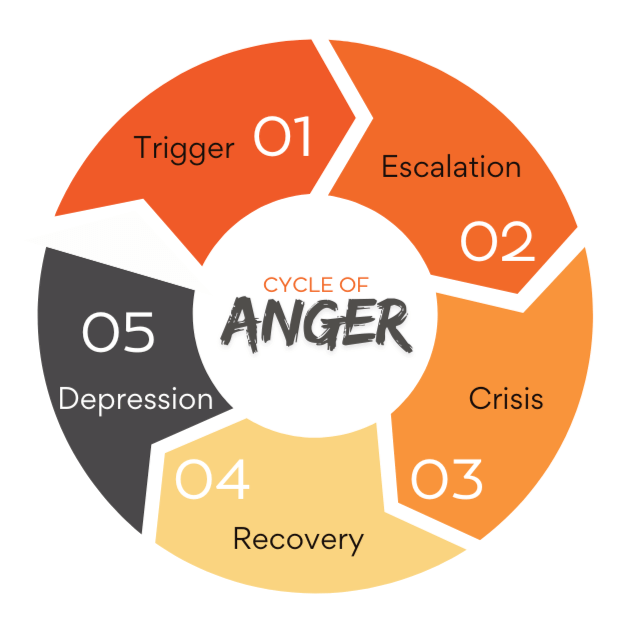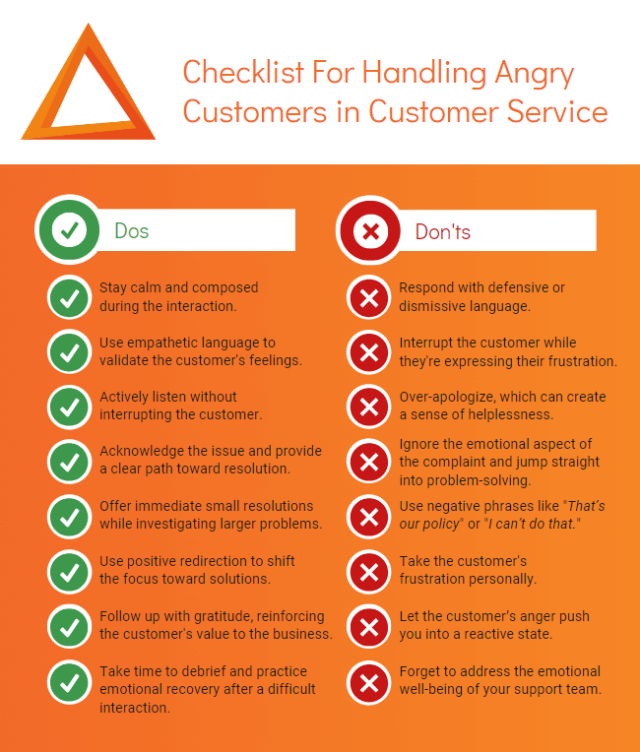Handling angry customers can be one of the toughest challenges in customer service, but it’s also one of the most valuable opportunities. Customers’ frustration often reflects a gap between their expectations and experience, signaling a need for connection and validation. These moments offer a chance to fix the issue, rebuild trust, and deepen the relationship.

AT NAOS CX, we understand the complexities of customer interactions and are committed to helping you turn every negative situation into a chance to shine. The insights you’ll find in this article come from research and years of experience delivering superior customer service, so you’re in the right place to learn how to navigate these difficult moments with skill and empathy.
By the end of this article, you will learn how to train your teams to handle angry customer interactions and reinforce long-term loyalty.
=> Don’t miss the latest episode of our Podcast, the CS Training Conversation! You’ll learn everything you need to know about how to deal with angry customers.
6 TIPS TO DEAL WITH ANGRY CUSTOMERS
INC highlights that “negative customer experiences lead to bad reviews, and a bad review can do serious damage – the kind that makes more than a good review to fix.”
So, when the phone rings with an angry voice on the other end or a critical email lands in your inbox, it can feel like the world is crashing down.
However, these challenges are opportunities in disguise. Each interaction with an upset customer is your chance to showcase your commitment to their satisfaction.
Here’s how to handle the situation with grace.
Understanding the Cycle of Anger to Respond Effectively
When managing angry customers, it’s easy to assume their frustration is solely due to a service issue or product fault. However, the reality is often more complex. An angry customer’s reaction typically follows a deeper emotional cycle triggered by external and internal factors. By understanding both the Cycle of Anger and the types of frustration you encounter, your team can better adapt their responses and de-escalate situations effectively.
Types of Anger: Justified vs. Exaggerated
Not all customer anger is the same, and recognizing the difference between justified frustration and exaggerated anger is critical to an appropriate response.
- Justified frustration occurs when the customer has experienced a genuine issue, such as a faulty product or missed deadline. Quick action combined with genuine empathy is essential to repair the relationship.
For more on how to effectively handle complaints, check out our previous article: How to Handle Customer Complaints: Best Practices To Make Your Customers Love You (Even When They’re Mad!).
- Exaggerated or misplaced anger may stem from external factors unrelated to your business, such as personal stress. Customers often use your team as an outlet for unrelated frustrations in these situations. Here, active listening is the most valuable tool. Acknowledging their feelings can help diffuse the heightened emotion, even if the issue is outside your service.

The Cycle of Anger
The emotional journey of anger follows five phases:
- Trigger: The customer perceives a specific failure (e.g., late delivery or poor service), activating frustration.
- Escalation: Their frustration builds physically and emotionally, often leading to a sharper tone or harsh words.
- Crisis: This is the peak of anger. The customer is highly reactive during this phase, and logic may be impaired. Immediate problem-solving here often fails; instead, active listening and calmness are crucial.
- Recovery: As the customer vents and begins to calm down, they’re more receptive to dialogue and resolution.
- Depression: After cooling off, the customer may experience regret or embarrassment. This is an opportunity to rebuild trust and strengthen the relationship.

Tailoring Responses Based on the Cycle
- In the Crisis Phase, focus on de-escalation rather than problem-solving. Use calm tones and avoid defensive reactions, saying, “I can see this is frustrating, and I want to help.”
- In the Recovery Phase, once the customer’s anger subsides, they are more open to discussing resolutions. This is your chance to offer solutions and repair the relationship.
Recognizing where a customer is within the Cycle of Anger and understanding the type of frustration they’re experiencing allows your team to address the surface issues and the underlying emotions, ensuring a more effective resolution.
Building Rapport: The Key to Diffusing Anger Early
When dealing with frustrated customers, the first step toward resolution isn’t always a solution—it’s a connection. Building rapport is vital to calming an upset customer and shifting the dynamic from confrontation to collaboration. The earlier you recognize signs of frustration, the sooner you can take action to prevent escalation.
One powerful tool to achieve this is the Triple-A Approach: Alter, Avoid, Accept. By understanding potential triggers and making small adjustments to your interaction style, your team can turn heated moments into productive conversations.
- Alter: The moment you notice frustration—perhaps in a customer’s tone, pace, or word choice—alter your approach. Slow your speaking pace, soften your tone, and acknowledge their emotions. This simple shift in communication can defuse tension before it escalates.
- Example: “I can hear that this has been a frustrating experience for you. Let’s work together to resolve it.”
- Avoid: Avoid fueling the customer’s anger by staying neutral. Don’t take any comments personally, and avoid phrases like, “This is our policy,” which can feel dismissive and further irritate the customer. Instead, focus on how you can help, staying solution-oriented without getting defensive.
- Example: “I understand this issue is frustrating, and I’m here to find a solution with you.”
- Accept: Accept that some situations are beyond your immediate control, such as delays or external challenges, and focus on what you can manage. Accepting the reality of the situation allows you to respond with empathy and honesty, which builds trust.
- Example: “I understand this situation isn’t ideal. Let me explain what we can do to make things right.”

Practical Scripts to Build Rapport Quickly:
- Show empathy: “I can see why you’d feel this way; I would feel the same in your situation. Let’s find a solution together.”
- Validate their experience: “Thank you for sharing this with me. I’m here to make sure we resolve this from now on.”
- Keep the focus on the customer: “Can you tell me more about what happened so we can address it?”
By recognizing early signs of frustration and using the Triple-A Approach, your team can alter the course of the interaction before it spirals out of control, creating a more collaborative and positive dialogue with the customer.
Mastering Active Listening: Beyond Just Hearing the Words
Science Direct mentions that active listening can help restore a “damaged customer relationship.”
However, active listening isn’t only about hearing your customer’s words. The key is to understand the emotional current that flows beneath the words.
One technique you need to learn here is empathetic silence. George R.R. Martin, one of the most beloved American authors, says, “Empathetic silence is one of the most underused weapons in the world.”
So, after a customer finishes sharing their frustration, consider taking a few moments of pause before responding.
This silence might initially feel awkward, but it serves a vital purpose: it allows customers to fully vent their feelings without fearing being interrupted. During this, they may share additional insights, which might help you gather more context about their concerns.
Further, when on a call, nonverbal cues matter, too. Simple affirmations like “mm-hmm,” “I see,” or even a gentle “That sounds really frustrating” signal to customers that you’re engaged and interested in their experience.
These little nudges encourage them to continue speaking, which can reduce their emotional intensity.
Additionally, distinguishing between emotion and fact is another essential element of active listening. Customers often voice emotional complaints that express their feelings, like, “You messed things up for me!”
While their feelings are valid, these statements can cloud the underlying issue. In contrast, factual complaints – such as “The product arrived damaged” – are more precise and straightforward. Recognizing this distinction can help you respond more effectively.
Stay in Control by Shifting Customers Out of ‘Fight Mode’
Staying composed is essential to managing customer anger effectively in high-pressure situations. When frustration peaks, the customer often enters a state of fight or flight, where their instinctive reaction takes over. In this state, their ability to process logical solutions is diminished, making it even more critical for your team to maintain control and de-escalate the situation.

Responding with calm, positive language can help shift customers out of fight mode and allow them to regain their rational thinking. Here’s how to do it:
- Positive Redirection: When a customer expresses frustration, reframe their comments in a positive light. For instance, if a customer says, “Your service is terrible,” you might respond with, “I appreciate your honesty, and I see how frustrating this has been for you. Let’s work together to make it right.” This approach demonstrates your commitment to finding a solution.
- Be Cautious with Apologies: While acknowledging a mistake is important, over-apologizing can create an impression of helplessness. So, consider balancing your apologies with a proactive approach. For example, say, “I understand your concern, and while I’m sorry for the oversight, I’m already contacting our team to expedite your request.” This reassures the customer that you focus on resolving the issue.
- Manage Your Emotions through grounding techniques like:
- Mindful Breathing: When you feel tension rising, pause and take a few deep, slow breaths. Inhale for four counts, hold for four, then exhale for six. This simple exercise can help you regain composure.
- Reflective Visualization: Think of when you successfully resolved a customer issue. This mental exercise can boost your confidence and remind you that you have the skills to handle the situation.
- Use Neutral, Calming Language: The words you choose can affect the tone of the conversation. Steer clear of negative phrases like “I can’t do that” or “That’s not our policy.” Instead, use constructive language like, “Let’s explore the options we have to address your concern.” This approach encourages collaboration toward a solution.
Your ability to stay calm directly influences how quickly a customer can move from emotional reaction to problem-solving. By setting a calm tone, you signal that the situation can be resolved, helping the customer regain control.
Providing Solutions: Three-Step Resolution Framework
Once you acknowledge your customer’s situation, you need to take steps to resolve their pain points. This 3-step framework might help.
- Empathize first
Always begin by addressing the emotional dimension of the conversation. Put simply, you don’t need to reiterate the facts right away. Instead, try an empathetic approach.
-
- Example: “I can hear how much this situation has upset you; it’s completely understandable to feel that way.”
This validation helps the customer feel heard and acknowledged and sets the stage for a more productive conversation.
- Acknowledge the issue in their words
Repeat their issue back to them using their language to show that you fully understand the specifics of their complaint.
-
- Example: “You mentioned the delivery was supposed to arrive last week, and I see how that is incredibly inconvenient for you.”
Using their language will reinforce your understanding and show them you listen actively to their concerns.
- Offer an immediate, small resolution:
While working on a long-term solution, providing an immediate, small resolution helps convey goodwill. It buys you time to investigate the larger issue and demonstrates your proactive commitment to making things right.
-
- Example: “While we look into the problem, I’d like to offer you a 20% discount on your next purchase as a thank you for your patience. I’ll also make sure to keep you updated on the status of your order.”

Using Emotional Anchoring to Build Future Trust
After addressing the immediate concern, go a step further by emotionally anchoring the solution to future interactions. This means linking the customer’s current resolution to a positive future experience. Doing so shifts the conversation from simply resolving an issue to building long-term trust.
-
- Example: “I’m confident that the adjustments we’ve made today will ensure your next experience with us is much smoother. We truly value your business, and we’ll continue working to meet your expectations moving forward.”
Emotional anchoring helps turn an immediate resolution into a trust-building opportunity. Connecting today’s solution to a better future experience reinforces the customer’s loyalty and demonstrates your commitment to their long-term satisfaction.
Aftercare: Ensuring Positive Post-Interaction Recovery for Both Customer and Support Team
Positive Customer Aftercare Through Gratitude
After resolving a customer’s issue, the interaction doesn’t end there. Following up with a thoughtful, gratitude-based message can turn a resolved problem into a lasting positive impression. Instead of a generic follow-up, express genuine appreciation for the opportunity they gave your team to improve your service. This simple act of gratitude reinforces their importance to your business and leaves a lasting positive emotional impact.
-
- Example: “Thank you for bringing this to our attention. We truly appreciate your feedback as it helps us continue to improve our service for you and all our customers. If you need anything else, we’re here to help.”
This personalized, gratitude-driven message reinforces your commitment to customer satisfaction and helps turn a potentially harmful experience into one of loyalty and trust-building.
Support Team Recovery and Emotional Resilience
Just as customer aftercare is essential, so is the well-being of your support team. After a difficult interaction, creating space for the agent to reflect and recover is essential.

This can be done through quick debrief sessions, where team members can share their experiences and strategies. Additionally, incorporating anger de-escalation techniques, like mindfulness or stretching exercises, can help restore emotional balance and prevent burnout.
-
- Example: After a tough call, team members can take a moment to practice mindful breathing or a brief stretch to release tension. This not only boosts morale but also helps support emotional resilience.
Encouraging these practices builds a healthier work environment where your team feels supported and prepared to handle the next challenge with renewed energy.
ESSENTIAL DO’S AND DON’TS FOR HANDLING ANGRY CUSTOMERS
As this article explores, managing angry customers requires a balance of empathy, active listening, and emotional resilience. To help your team stay on track, here’s a quick reference guide to the essential Do’s and Don’ts of handling customer frustration.

Use these principles to ensure that your team remains calm, constructive, and focused on turning negative experiences into opportunities for long-term loyalty.
CONCLUSION
Handling angry customers can feel overwhelming, but it’s also a powerful opportunity to strengthen connections and improve your service. When approached constructively, every frustration is a chance to identify gaps, learn, and grow. By taking the time to empathize, listen, and address their emotional and practical concerns, you resolve the immediate issue and enhance your ability to serve future customers more effectively.
Remember, constructive disagreement is a pathway to improvement. What may seem like a negative experience can become an invaluable learning opportunity that helps refine your processes and customer interactions. Some of the angriest customers have the potential to become your most loyal advocates—when they feel heard, valued, and respected.
Explore NAOS CX’s resources to enhance your team’s emotional resilience and customer-handling skills. You’ll find the tools to deliver exceptional customer experiences and transform challenges into growth opportunities.
BONUS! Listen to our best tips to deal with angry customers here:
CS Training Conversation Podcast.

